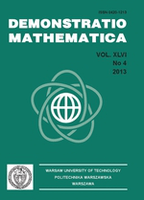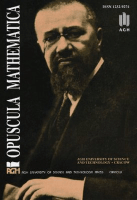
Demonstratio Mathematica
Scope & Guideline
Unveiling the Beauty of Mathematical Concepts
Introduction
Aims and Scopes
- Fractional Calculus and Differential Equations:
The journal extensively covers topics related to fractional calculus, exploring its applications in differential equations, stability theory, and boundary value problems. - Numerical Methods and Algorithms:
Research on innovative numerical methods, including finite difference methods, iterative algorithms, and approximation techniques for solving complex mathematical models, is a core focus. - Functional and Operator Theory:
Papers often delve into the properties of various operators, including bounded linear operators, and explore their applications in functional analysis and operator theory. - Fixed Point Theory and Its Applications:
The journal features studies on fixed point theorems, including new results and generalizations in metric spaces, with applications in various mathematical problems. - Mathematical Modeling and Control Theory:
There is a significant emphasis on mathematical modeling of real-world phenomena, particularly in control theory, dynamical systems, and epidemiological models. - Topology and Geometry:
Research addressing topological spaces, geometric properties, and their applications in various mathematical contexts is frequently published.
Trending and Emerging
- Fractional Differential Equations:
There is a growing trend in the exploration of fractional differential equations, reflecting their increasing relevance in modeling complex dynamic systems across various fields. - Machine Learning and Data Analysis:
Recent publications indicate a rising interest in the intersection of mathematics with machine learning and data analysis, showcasing innovative applications of mathematical theories in computational contexts. - Stability Analysis of Dynamical Systems:
An increasing number of papers are dedicated to the stability analysis of various dynamical systems, indicating a trend towards understanding long-term behaviors and solution properties. - Applications of Topological Methods:
Emerging research is highlighting the applications of topological methods in various mathematical problems, emphasizing the relevance of topology in contemporary mathematical research. - Complex and Hybrid Systems:
There is a notable trend towards studying complex and hybrid systems, particularly in the context of mathematical modeling and control, reflecting a shift towards interdisciplinary approaches in mathematical research.
Declining or Waning
- Classical Analysis Techniques:
Papers focusing on traditional methods of classical analysis, such as elementary techniques in calculus or basic function theory, appear to be less common as the journal shifts towards more advanced and specialized topics. - Elementary Algebraic Structures:
Research concerning basic algebraic structures, such as simple groups or elementary number theory, seems to be waning, with a noticeable move towards more complex algebraic frameworks and applications. - Basic Probability Theory:
There is a noticeable decline in papers dedicated to fundamental concepts in probability theory, with fewer contributions focusing solely on classical probabilistic models.
Similar Journals

Research in Mathematics
Catalyzing a revolution in mathematical thought and practice.Research in Mathematics, published by TAYLOR & FRANCIS LTD, is an emerging academic journal dedicated to advancing the field of mathematics through innovative research and scholarship. With an E-ISSN of 2768-4830, this journal aims to foster discussion and dissemination of high-quality mathematical research across a broad spectrum of disciplines, including pure mathematics and applied mathematics. As part of its commitment to accessibility, Research in Mathematics operates on an open-access model, allowing researchers, professionals, and students to engage with groundbreaking studies without barriers. Despite its recent establishment since 2016, and with a current Scopus ranking that positions it in the lower percentile among its peers, the journal offers a platform for new voices in the mathematics community. Its objectives include enhancing visibility for novel mathematical concepts, methodologies, and applications that can significantly impact the academic and professional landscapes. Authors are encouraged to submit original research articles, review papers, and case studies that push the boundaries of mathematical knowledge.

Rendiconti del Circolo Matematico di Palermo
Showcasing Innovative Research in Mathematics.Rendiconti del Circolo Matematico di Palermo, published by SPRINGER-VERLAG ITALIA SRL, is a revered journal in the field of mathematics, emphasizing the cultivation and dissemination of mathematical knowledge since its inception in 1887. With its ISSN 0009-725X and E-ISSN 1973-4409, this esteemed publication has continued to thrive, showcasing innovative research, comprehensive reviews, and thoughtful discussions from diverse areas in mathematics, particularly in its Q2 ranking within the miscellaneous mathematics category. Its historical significance is underscored by its convergence of publications across numerous years, including its notable periods from 1887 to 1916, 1919 to 1938, and beyond, effectively capturing the evolution of mathematical thought. Though not open access, the journal remains an essential resource for researchers, professionals, and students aiming to stay updated with the latest advancements and methodologies in the ever-evolving landscape of mathematics. With its Scopus rank placing it in the top 25th percentile, Rendiconti del Circolo Matematico di Palermo continues to be a cornerstone for scholarly dialogue and development in its domain.

Ukrainian Mathematical Journal
Fostering Collaboration in Mathematical ResearchThe Ukrainian Mathematical Journal is a prominent academic publication in the field of mathematics, focusing on a diverse range of topics that appeal to researchers, professionals, and students alike. Published by Springer, this journal has been an important platform for disseminating significant mathematical research since its inception in 1957. With the aim of fostering knowledge and collaboration within the mathematical community, the journal curates high-quality articles that meet rigorous scholarly standards, evidenced by its Q3 ranking in the miscellaneous mathematics category for 2023. Although it currently does not offer open access, the journal remains accessible through various institutional subscriptions. It serves as a vital resource for ongoing discourse in the field and invites contributions that further advance mathematical understanding.

Opuscula Mathematica
Fostering Innovation in Mathematical ResearchOpuscula Mathematica is an esteemed open-access journal published by AGH University of Science & Technology Press in Poland, specializing in the field of mathematics. Since its inception, it has provided a collaborative platform for researchers and scholars to share innovative mathematical insights and solutions, expanding its reach globally. With an impressive Q2 ranking in the realm of miscellaneous mathematics for 2023 and a notable Scopus ranking of Rank #139/399, it stands as a significant conduit for researchers seeking to publish high-quality, peer-reviewed articles. The journal has embraced open-access principles since 2004, ensuring that advancements in mathematical research are accessible to all. By publishing original research, reviews, and scholarly notes, Opuscula Mathematica plays a pivotal role in enhancing the visibility of vital mathematical discoveries and fostering academic discourse. Its convergence years from 2012 to 2024 highlight the journal's commitment to ongoing relevance and evolution in a dynamic research landscape.

Results in Mathematics
Pioneering Discoveries in Applied and Theoretical Mathematics.Results in Mathematics, published by SPRINGER BASEL AG, is a prestigious academic journal dedicated to advancing the field of mathematics since its inception in 1978. Based in Switzerland, this journal has garnered a significant reputation, holding a Q2 ranking in both Applied Mathematics and miscellaneous Mathematics categories according to the latest 2023 metrics. The journal is a vital resource for researchers, professionals, and students, encouraging open dialogue about emerging mathematical concepts and methodologies. Our editorial objective is to publish high-quality research articles that contribute to theoretical advancements and practical applications in mathematics. Although it does not currently offer open access options, it provides in-depth studies and articles that fortify the knowledge base within the mathematical community. With a commitment to innovation and academic rigor, Results in Mathematics continues to serve as an essential platform for scholarly communication and exploration.

Pure and Applied Mathematics Quarterly
Elevating Research in Pure and Applied MathematicsPure and Applied Mathematics Quarterly is a prestigious journal published by INT PRESS BOSTON, INC, focusing on the diverse and evolving field of mathematics. Since its inception in 2007, this journal has grown significantly, currently holding a Q1 ranking in the Mathematics (Miscellaneous) category for 2023, positioning it among the leading publications in the discipline. With a commitment to publishing high-quality research, Pure and Applied Mathematics Quarterly fosters innovation and dialogue within the mathematical community by providing a platform for theoretical advancements and practical applications. The journal remains accessible to researchers and professionals through its ISSN 1558-8599 and E-ISSN 1558-8602, although it does not currently offer open access. As a vital resource for mathematicians, educators, and students, this journal endeavors to expand the frontiers of mathematical knowledge and contribute to the academic dialogue surrounding this fundamental science.

Matematicki Vesnik
Elevating mathematical insights for researchers and students alike.Matematicki Vesnik is a distinguished open-access journal published by the MATH SOC SERBIA-DRUSTVO MATEMATICARA SRBIJE, dedicated to advancing the field of mathematics since its inception. With an ISSN of 0025-5165 and an E-ISSN of 2406-0682, this journal has been a significant platform for disseminating research findings since its establishment in 1993. Hosted in Serbia, it embraces a broad scope of mathematical discourse while achieving a Q3 category ranking in miscellaneous mathematics for 2023. As part of its commitment to fostering scholarly communication, Matematicki Vesnik is accessible to a global audience, promoting high-quality research and innovative ideas within the mathematical community. With converged years from 1999 to 2024 and a Scopus rank of #232 out of 399 in General Mathematics, the journal plays a crucial role in enhancing visibility and impact for researchers, professionals, and students alike in the dynamic landscape of mathematical inquiry.

Korean Journal of Mathematics
Exploring the Depths of Mathematical Theory.The Korean Journal of Mathematics, published by the Kangwon-Kyungki Mathematical Society, is an esteemed platform dedicated to advancing the field of mathematics. With an ISSN of 1976-8605 and E-ISSN of 2288-1433, the journal features a range of scholarly articles that emphasize both theoretical and applied aspects of mathematics, catering to researchers, professionals, and students alike. Although it is not open access, the journal maintains a commitment to academic rigor and integrity, ensuring high-quality contributions to the mathematical community. As it converges from years 2021 to 2024, the Korean Journal of Mathematics is poised to enhance its visibility within the Scopus database, currently ranking #354 out of 399 in the general mathematics category, reflecting its potential for growth and impact in the mathematical sciences. With its strategic focus and institutional backing from Kangwon National University, the journal serves as a vital resource for fostering research and dialogue in the ever-evolving landscape of mathematics.

Ufa Mathematical Journal
Pioneering High-Quality Research in Mathematical SciencesUfa Mathematical Journal, published by the Institute of Mathematics and Computer Center in Russia, is an esteemed platform dedicated to the dissemination of high-quality research in the field of mathematics. With its ISSN 2074-1863 and E-ISSN 2074-1871, the journal serves as a vital resource for mathematicians, researchers, and academicians seeking to explore innovative methodologies and findings in various mathematical domains. Although presently operating under a subscription model, the journal’s commitment to advancing mathematical knowledge is underscored by its rigorous peer-review process and its aim to contribute significantly to the global mathematical community. With a focus on original research articles, the Ufa Mathematical Journal plays an essential role in fostering scholarly dialogue and collaboration among professionals in the field.

Tamkang Journal of Mathematics
Illuminating the Path of Mathematics in Science and BeyondTamkang Journal of Mathematics, published by TAMKANG UNIVERSITY, serves as a vital platform for researchers and professionals in the fields of applied mathematics, general mathematics, and materials science. With an ISSN of 0049-2930 and an E-ISSN of 2073-9826, this journal has established itself within the academic community, particularly noted for its contributions from Taiwan. Although categorized as Q4 in Applied Mathematics and Q3 in multiple related fields according to the 2023 ranking, it maintains a solid reputation for disseminating significant research findings and innovative methodologies. Researchers can explore an array of topics within its pages, making it an excellent resource for enhancing mathematical knowledge and applications. As it converges from 2005 to 2024, the journal invites academics, professionals, and students to engage with its content and contribute to the ongoing dialogue in mathematics and its interdisciplinary applications.